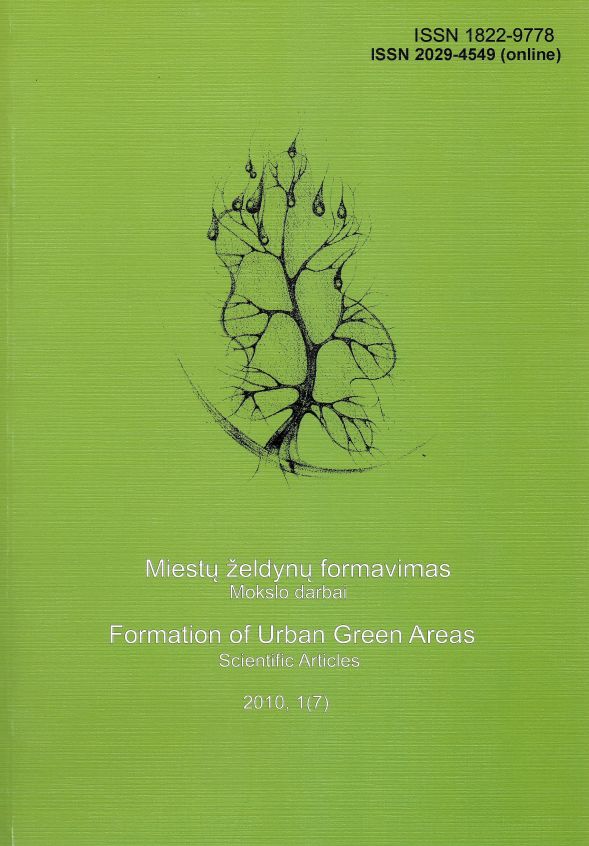Buvusių dvarų sodybų želdynai ir jų tvarkymas
Reikšminiai žodžiai:
dvaro sodyba, parkas, rūšis, formaSantrauka
1999–2009 m. buvo ištirta per 200 šalies dvarų parkų. Pagal išplanavimo pobūdį šiuos parkus galima būtų suskirstyti taip: geometrinio plano – 55 parkai (27,5 %), mišraus – 107 (53,5 %) ir peizažiniai – 38 (19 %). Iš viso šalies dvarų parkuose šiuo metu auga apie 350 introdukuotų sumedėjusių augalų rūšių ir dekoratyvinių formų (Pinophyta – 95, Magnoliophyta – 255), priklausančių 39 šeimoms ir 93 gentims (Pinophyta – 4 šeimos ir 11 genčių, Magnoliophyta – 35 ir 82). Kiekvieno senojo parko renovaciją reiktų pradėti nuo elementarių jo tvarkymo ir priežiūros darbų. Tai vadinamasis „rūdžių pašalinimas“ nuo seno meno kūrinio, leidžiantis aiškiau pajausti šio kūrinio dvasią ir parinkti tinkamiausius renovacijos kelius ir metodus. Vykdant renovacijos darbus, pagrindinį dėmesį reikia skirti parko erdvinei struktūrai atkurti. Gerai prižiūrimi parkai, išsaugodami daugiau ar mažiau ryškius autentiškumo bruožus, išgyvena 200–300 metų. Kiekviena karta jiems suteikia kažką savo, pritaikydama savo poreikiams ir interesams bei savo laikmečio dvasiai.
Nuorodos
Griffiths M. Index of Garden Plants. Bath: Macmillan, 1997, 1234 p.
Historic Gardens (The Florence Charter 1981), adopted by ICOMOS in December 1982. Prieiga per internetą: http://www.international.icomos.org/e_floren.htm
International Charter for the Conservation and Restoration of Monuments and Sites (The Venice Charter 1964), adopted by ICOMOS in 1965. Prieiga per internetą: http://www.icomos.org/venice_charter.html
Januškevičius L. Lietuvos parkai ir jų dendroflora. Želdiniai ir jų dizainas. Respublikinės mokslinės-praktinės konferencijos straipsnių rinkinys. Vilnius, 2005. P. 25–39
Januškevičius L. Lietuvos parkai ir jų introdukuota dendroflora. Mūsų girios, Nr. 5, 2003. P. 13–14
Januškevičius L. Lietuvos parkai. Kaunas, 2004, 485 p.
Januškevičius L. Vakarų Lietuvos senųjų parkų egzotiniai medžiai ir krūmai. Vytauto Didžiojo universiteto botanikos sodo raštai. 2001, Nr. 10. P. 88–107
Januškevičius L., Budriūnas A.R. Lietuvoje auginami medžiai ir krūmai. Vilnius, 1987, 187 p.
Krüssmann G. Bd. 1–486 S; 1977. Bd. 2–466 S; 1978. Bd. 3–496 S. Handbuch der Laubgehölze. Berlin und Hamburg: Paul Parey, 1976
Krüssmann G. Handbuch der Nadelgehölze. Berlin und Hamburg: Paul Parey, 1983, 396 S.
Lietuvos Respublikos Želdynų įstatymas. Priimtas Lietuvos Respublikos Seimo 2007-6-28, Nr. X–1241. Prieiga per internetą: http://www3.lrs.lt/pls/inter3/dokpaieska.showdoc_l?p_id=301807&p_query=&p_tr2=
Ramanauskas V., Čibiras L., Džiaukštas P. ir kt. Dendrologija. Vilnius, 1973, 319 p.
Snarskis P., Galinis M. Vadovas Lietuvos dekoratyviniams medžiams ir krūmams pažinti. Vilnius, 1974, 249 p.
Želdynų apsaugos, tvarkymo ir atkūrimo strategija. Patvirtinta Lietuvos Respublikos aplinkos ministro 2002-11-29 įsakymu Nr. 615. Prieiga per internetą: http://www3.lrs.lt/pls/inter3/dokpaieska.showdoc_l?p_id=198061&p_query=&p_tr2=


